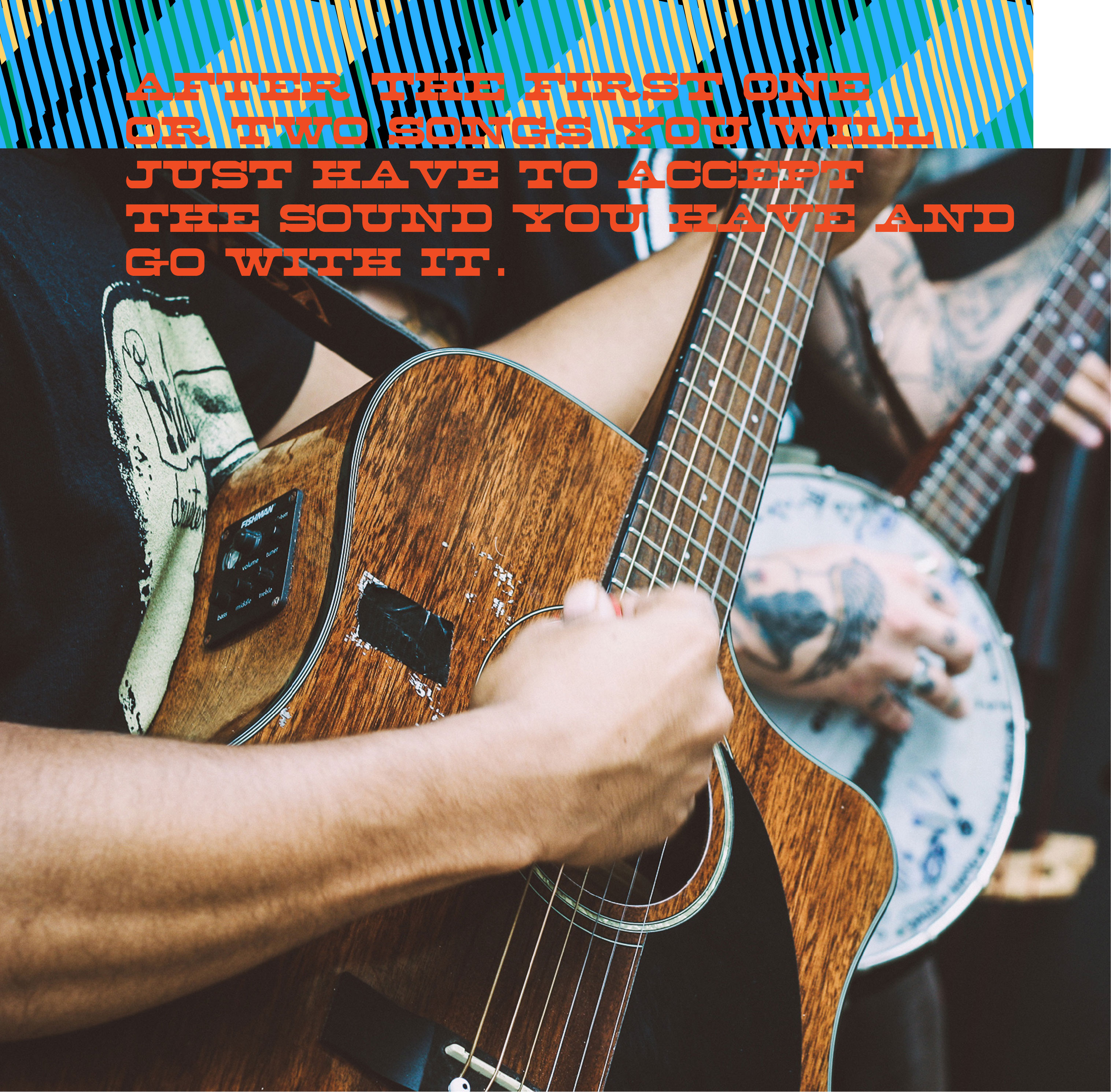 Doing an acoustic gig should be as much fun as a band gig and could potentially be better money. It also comes with its own set of challenges that can severely affect the fun and success you may have. In the last three decades, I’ve done many acoustic gigs, ranging from living room venues to halls that seat a thousand. I’ve also talked to many of my colleagues about their experiences and what it takes to get the job done.
Doing an acoustic gig should be as much fun as a band gig and could potentially be better money. It also comes with its own set of challenges that can severely affect the fun and success you may have. In the last three decades, I’ve done many acoustic gigs, ranging from living room venues to halls that seat a thousand. I’ve also talked to many of my colleagues about their experiences and what it takes to get the job done.
One of the most challenging issues for an acoustic guitar player in an amplified situation is feedback. And I don’t mean comments by the audience about your performance (although that can become an issue too – wink). There are 2 types of feedback you can get: low and high. My experience is that the low feedback is the hardest to deal with. As a rule it’s always best to keep the level of sound on stage as low as possible to avoid feedback. But this, of course, also limits the sound that reaches your ear. Crowd noise can add to the problem (if your beautiful finger picking and insightful lyrics don’t keep them quiet).
Playing with a mic’d guitar and a monitor on stage is asking for trouble as your vocals will run through the monitors and add to the problem. This is especially true if you are on a hollow wooden stage, if the ceiling is low and/or the walls are not dampened (all of which are well beyond your control). Amplifying a guitar with a mic through a PA is generally only possible if you have a good sound engineer, use in-ear monitors (or very low monitoring) and are not close to Front Of House (FOH) speakers. The sound engineer will have to EQ the guitar quite a bit; cut everything below 120 Hz, tweak the highs and try to find feedback frequencies. They could also use an automated feedback suppressor. They won’t be able to walk away from the board after the first few songs (some of them do, really!), but ride the faders and tweak the knobs throughout the gig.
 If you don’t have a sound engineer, forget about a feedback suppressor (pedal). They just don’t work in a practical live situation. Every room is different and tweaking the sound to suppress feedback in different frequency ranges takes a lot of time and a lot of experience. Plus these parameters can change during the gig due to changes in the acoustics in the room (more or Jimi-forbid less audience), use of capo, open tunings or distance to the mic.
If you don’t have a sound engineer, forget about a feedback suppressor (pedal). They just don’t work in a practical live situation. Every room is different and tweaking the sound to suppress feedback in different frequency ranges takes a lot of time and a lot of experience. Plus these parameters can change during the gig due to changes in the acoustics in the room (more or Jimi-forbid less audience), use of capo, open tunings or distance to the mic.
During the sound check – if you have that luxury – the hall is often empty. Which will give you different audio characteristics once the gig starts. And the only thing these suppressors will do during the gig is distract you.
There are sound hole covers for acoustic guitars that can help a bit in the reducing feedback risk. They are generally only used when you’re playing big stages, in a band and the FOH speakers are set to 11. In those situations, you will have to play with in-ears anyway and the difference a sound hole cover makes is quite small. It can reduce feedback problems in the higher ranges, but also affects the overall quality of the sound. Your expensive pre-war Martin will start to sound like a cardboard rip-off.
Playing through a dedicated amp can work, if you are careful in placing it. Mine usually sits behind me (raised), so that my body forms a barrier between the guitar and/or mic and the amp. Sometimes it works to place the amp in front of you, facing you in an angle upward; especially in a situation where any form of amplification of the guitar is too much for the audience, but still necessary for you (like a living room concert with concrete harsh sounding walls).
Only use a dedicated acoustic amp like an AER, Fishman, Roland AC or similar. Your Marshall stack or Twin Reverb is not designed to amplify the wide spectrum an acoustic guitar exhales. Some of these amps have dual inputs, which gives you the option to run your vocal mic through it also. It’s useful to source a flexible, lightweight solution for living room type situations, where you only need a tiny boost.
When I don’t trust the setup the venue has, I bring my own. Meaning a small PA with monitoring. In that case, I know for sure MY sound will be at least acceptable. I can use it just for monitoring or if the PA they have really is a joke then it can also take care of the FOH sound. In most acoustic situations, you’ll be relying on a guitar pickup for amplification.
![]() The best of acoustic guitar pickups often use a two-way system, with a piëzo pickup under the bridge and a small mic inside the guitar. In most situations, you can add a trifle of the internal mic to the mix – which definitely adds to the quality of the sound. But in loud situations, you’ll be depending on the piëzo and will have to nix the sound out of the internal mic. To tweak your sound a bit you can buy a dedicated pre-amp/DI-box if you are running the guitar through the PA.
The best of acoustic guitar pickups often use a two-way system, with a piëzo pickup under the bridge and a small mic inside the guitar. In most situations, you can add a trifle of the internal mic to the mix – which definitely adds to the quality of the sound. But in loud situations, you’ll be depending on the piëzo and will have to nix the sound out of the internal mic. To tweak your sound a bit you can buy a dedicated pre-amp/DI-box if you are running the guitar through the PA.
After the first one or two songs you will just have to accept the sound you have and go with it. Seven out of ten times that sound will be okay at best. Two out of ten times the sound will be horrible and one out of every ten gigs you’ll be in audio heaven. And this goes for any level of solo acoustic player who sings in any situation. Trust me on this: I’ve talked to many of the big guys and gals and it’s never been different. Go with the flow. Continued tweaking of high, low, less or more reverb/delay will keep you and the audience out of the zone. So stay away from the knobs while you’re performing as much as you can.
Bring your own vocal mic and/or guitar mic. The ones they have at the venue contain the bacteria of all those who spit in it before you, and almost always sound crappy. Also bring your own mic stand. No seriously! Don’t trust the owner who says they have top-notch gear. It’ll fall down, will have been fixed with sticky duck tape or will not stay in position. Bring two sets of cables if you are using a dynamic mic: one with XLR and one with Jack. When you are using a condenser vocal mic, ask ahead if they have phantom power on the PA. Don’t trust the club owner or barman to give you this info: ask the sound engineer. If you can’t get a hold of him, ask which PA they have and Google its specs.
 Bring workman’s gloves and haul your stuff around wearing them. Your hand will get dirty and sticky and you’ll be glued to your guitar if you don’t. So forget about that fast fingerstyle run in the first song. Sure, you can wash your hands right before the gig. But that removes the natural layer of skin grease you need to slide across the strings comfortably. Bring a small flashlight! Tweaking the knobs of your DI box in low light is a surefire road to feedback and a crappy sound. A volume pedal or bypass/kill switch is not a luxury when you are tuning, switching guitars or balancing the vocal mic with the guitar. Most foot pedal tuners automatically kill the sound, so that’s a double whammy.
Bring workman’s gloves and haul your stuff around wearing them. Your hand will get dirty and sticky and you’ll be glued to your guitar if you don’t. So forget about that fast fingerstyle run in the first song. Sure, you can wash your hands right before the gig. But that removes the natural layer of skin grease you need to slide across the strings comfortably. Bring a small flashlight! Tweaking the knobs of your DI box in low light is a surefire road to feedback and a crappy sound. A volume pedal or bypass/kill switch is not a luxury when you are tuning, switching guitars or balancing the vocal mic with the guitar. Most foot pedal tuners automatically kill the sound, so that’s a double whammy.
Bring a small towel to wipe the sweat from your hands during the gig. Stage lighting can be very hot. Don’t change your strings right before the gig. They will go out of tune in the first songs.
Also bring your social skills. If you are lucky enough to have a sound engineer, buy them a beer (one!) and engage with some light small talk. It’s not a solo gig when you have a sound engineer. They can make you look good or ruin your chances of a fun and successful night.
Preparation is key when doing any gig. And that goes for solo and duo acoustic gigs a thousand times over. There is no place to hide; it’s all you. Be on time, come prepared, have spares (a second guitar for when strings break and an extra battery for your pickup, tuner, effects) and keep smiling! There’s nothing like singing a song and strumming a six string in front of a captivated audience.

